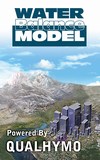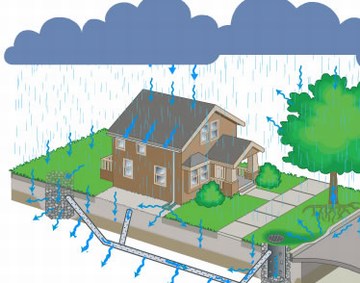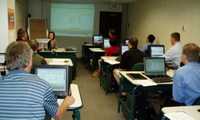Community of Users Inform Platform Conversion for Water Balance Model
Note to Reader:
This article is the fourth in a series that foreshadow the information-transfer that will take place at the 2011 Water Balance Model Forum on April 7. To download a PDF version of the article below, click on Community of Users Inform Platform Conversion for Water Balance Model.
The article is about training sessions hosted by the City of Surrey prior to the Partners Forum. Attended by engineering consultants, these sessions provided a valuable feedback loop on the user experience. This is important because the web interface is being converted to a new platform.
A Tool for Assessing Green Infrastructure Effectiveness in Protecting Stream Health
The Water Balance Model is a web-based tool to assess green infrastructure effectiveness. The user can correlate runoff volume management strategies with stream erosion and water quality outcomes. This process allows the delivery of watershed-specific and outcome-oriented plans that are specifically applicable to the municipality, watershed and stream.
The Water Balance Model Differs from Other Tools
Launched in 2003 with high level political endorsement at the annual convention of the Union of British Columbia Municipalities, the Water Balance Model differs from other drainage modelling tools in three fundamental ways:
- it is web-based;
- development is driven by the community of users; and
- it can help create a vision of the future watershed.
 “Since 2003, the Water Balance Model has been evolving in response to the needs-and-wants of our local government partners and the community of users. A key stakeholder group within the community of users is the consulting engineering group. These companies are our ‘paying subscribers,” states Ted van der Gulik, Chair of the Water Balance Model Partnership.
“Since 2003, the Water Balance Model has been evolving in response to the needs-and-wants of our local government partners and the community of users. A key stakeholder group within the community of users is the consulting engineering group. These companies are our ‘paying subscribers,” states Ted van der Gulik, Chair of the Water Balance Model Partnership.
To Learn More:
Click on Water Balance Model can create an understanding of the past and compare it to many possible futures — A key message is that the Water Balance Model is a ‘scenario comparison tool’. In other words, there is no restriction on the scenarios that users may choose to compare. The tool allows modellers to make transparent ‘what if’ assumptions.
2008 Platform Conversion: QUALHYMO Integration
“Integration of the Water Balance Model web interface with the QUALHYMO calculation engine triggered our first platform conversion during the period 2006-2008. Engineers wanted a tool that provided them with ‘one-stop shopping’ so that they could assess what happens once an on-site system reaches capacity and overflows into an off-site receiving system.”
“The QUALHYMO integration dramatically expanded the capabilities of the Water Balance Model. Our vision is that the tool is a means to an end in bridging the engineering and planning perspectives. Stream health is a function of erosion, and erosion is a consequence of changes in the integrity of the watershed landscape. When engineers and planners align their efforts to develop integrated solutions, a water-sensitive built form can do a lot to protect stream health,” concludes Ted van der Gulik.
To Learn More:
Click on Application of the Water Balance Model: Does it require more or less data than other drainage simulation tools? — The WBM uses the information gathered as part of a normal design process. It does not require the user to have more site information than required by any other system of design.

2011 Platform Conversion: WBM Express
 “Now we are proceeding with a second platform conversion in conjunction with developing the WBM Express for Homeowners, continues Richard Boase, Partnership Co-Chair. “The inspiration for this version resulted from the District of Central Saanich’s Surface Water Management Bylaw, adopted in February 2010. This regulatory tool requires rainwater capture, where it falls, when properties are developed or redeveloped. It also encourages use of the Water Balance Model.”
“Now we are proceeding with a second platform conversion in conjunction with developing the WBM Express for Homeowners, continues Richard Boase, Partnership Co-Chair. “The inspiration for this version resulted from the District of Central Saanich’s Surface Water Management Bylaw, adopted in February 2010. This regulatory tool requires rainwater capture, where it falls, when properties are developed or redeveloped. It also encourages use of the Water Balance Model.”
 “Discussions with Central Saanich staff (Nirmal Bhattachary and Roland Rocheleau) gave us an appreciation of the bylaw implications. We realized the moment had come to provide greater support for front counter staff in local government. They are the ones in contact with the public every day. So they are well-positioned to influence behaviour at the site scale.”
“Discussions with Central Saanich staff (Nirmal Bhattachary and Roland Rocheleau) gave us an appreciation of the bylaw implications. We realized the moment had come to provide greater support for front counter staff in local government. They are the ones in contact with the public every day. So they are well-positioned to influence behaviour at the site scale.”
“The platform conversion means we can implement other improvements and capabilities more efficiently and effectively. In the coming months, we will be rolling out four new modules: Stream Erosion; Water Re-Use; Climate Change; and Tree Canopy Interception,” concludes Richard Boase.
About the New Platform
 “The new Water Balance Model user interface will be generally comparable in overall layout to the existing site, but with a simpler and cleaner look. We are migrating from the existing Flex/PHP platform to a PHP/AJAX/HTML platform,” explains Dr. Charles Rowney, WBM Scientific Authority. He developed the QUALHYMO calculation engine in the 1980s with funding from the Ontario Ministry of Environment.
“The new Water Balance Model user interface will be generally comparable in overall layout to the existing site, but with a simpler and cleaner look. We are migrating from the existing Flex/PHP platform to a PHP/AJAX/HTML platform,” explains Dr. Charles Rowney, WBM Scientific Authority. He developed the QUALHYMO calculation engine in the 1980s with funding from the Ontario Ministry of Environment.
“The design decision to move to a new platform will ensure that the new site is robust and can be readily updated without the need for investment in proprietary support systems.”

Consultation with Paying Subscribers
“During the platform conversion process for the QUALHYMO integration, we convened a focus group session with our paying subscribers. The City of Surrey hosted this in a computer lab setting in July 2008. The group generated  a comprehensive list of 40-plus suggestions that we then systematically implemented over the following 6-month period,” recalls Ted van der Gulik.
a comprehensive list of 40-plus suggestions that we then systematically implemented over the following 6-month period,” recalls Ted van der Gulik.
“On March 24, we are again bringing together our paying subscribers as part of the consultation process for the current platform conversion. Again, we will be in a computer lab setting in the City of Surrey. Again, we will have experienced users in the room. Their experience provides us with a valuable feedback loop on what users like and/or what they might like to do differently.”
“It is significant that we have reached a critical mass in terms of the number of engineering consultants who have become Water Balance Model paying subscribers. Clearly, they see a value in the tool. In terms of the potential for outreach and training, we have only just scratched the surface. There is so much more that we intend to do to inform and educate the community of users about the scenario modelling capabilities of the Water Balance Model. Achieving this objective will be a higher priority in the months ahead.”
Water Balance Model Partners Forum
 “What we learn on March 24 will feed into the discussion at the Water Balance Model Partners Forum on April 7. We will conduct the Forum as a town-hall sharing, learning and consultation session. We will commence the rollout of the new platform and modules; showcase the vision for the WBM Express; and elaborate on how the Water Balance Model supports watershed-based planning,” explains Ted van der Gulik.
“What we learn on March 24 will feed into the discussion at the Water Balance Model Partners Forum on April 7. We will conduct the Forum as a town-hall sharing, learning and consultation session. We will commence the rollout of the new platform and modules; showcase the vision for the WBM Express; and elaborate on how the Water Balance Model supports watershed-based planning,” explains Ted van der Gulik.
“Periodically, the Water Balance Model Partnership holds a WBM Partners Forum. These gatherings typically serve two purposes: first, they provide an opportunity for local governments to reflect on what has been accomplished through alignment and collaboration; and secondly, they enable the leadership team to foreshadow where the inter-governmental initiative will lead next. The last Partners Forum was held in February 2008. It commenced the rollout of the QUALHYMO integration.”
To Learn More:
Click on Water Balance Model Partners Forum will showcase vision for ‘WBM Express for Homeowners’ — The vision for building the WBM Express is influenced by two existing web-based tools: Surrey’s ‘Sustainability in My Back Yard’ and North Vancouver’s ‘Geoweb-Community Solar Application’. The Surrey tool provides a picture and the North Van tool demonstrates the capabilities.
Posted in March 2011



